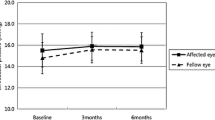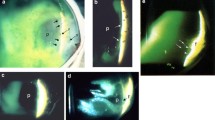Summary
Slit-lamp examination of bovine vitreous reveals a structural pattern which differs from that found in man. The entire vitreous cavity is filled with a nearly homogeneous substance whose optical proporties resemble the vitreous cortex of the human eye. The semifluid center found in man is lacking. Throughout the bovine vitreous there are zones of decreased density (so-called “holes”): prevascular fissueres (in front of retinal vessels) and a prepapillary “hole” (connected to Cloquet's canal). “Holes”, however, are absent over the area centralis (since there is no fovea) and over the ora serrata (since oral serrations are lacking).
However, aging changes, similar to those in man, are characteristically present: formation of vitreous tracts connected to structures of the anterior segment (ora serrata, Ligamentum medianum and lens border), and zones of liquefaction containing remnants of prevascular fissures. The vitreous tracts, however, have no apparent relationship to embryological structures (Cloquet's channel or hyaloid vessels). The insertion of Cloquet's channel at the posterior lens surface does not correspond, as is often assumed, to the hyaloid tract (plicated membrane inserting at the lens border) but actually to the arcuate line of Vogt (at the posterior pole of the lens). Thus experimental investigations using the bovine vitreous must be interpreted in the light of these variations.
Zusammenfassung
Spaltlampenuntersuchungen an enucleierten Rinderaugen zeigen, daß deren Glaskörper von homogener Struktur ist. Er hat in seiner ganzen Ausdehnung ungefähr die gleiche Dichte und die gleiche Strukturierung wie menschliche Glaskörperrinde. Prävasculäre Spalträume durchziehen den ganzen Glaskörperraum. Eine lockere Zentralsubstanz fehlt.
Die Altersevolution verläuft mutatis mutandis gleichartig wie beim Menschen mit der Bildung von Tractus vitreales und Destruktionshöhlen. Keine Beziehung besteht zwischen Tractus vitreales und embryonalen Strukturen. Der Tractus hyaloideus bildet nicht — wie oft behauptet wird — die Wand des Cloquetschen Kanals.
Experimentelle Ergebnisse von Untersuchungen an Rinderglaskörpern lassen sich nur mit Vorsicht auf menschliche Verhältnisse übertragen und müssen den grundsätzlich verschiedenen Grundbauplan der Glaskörperstruktur berücksichtigen.
Similar content being viewed by others
Literatur
Busacca, A.: Biomicroscopie et histopathologie de l'oeil, vol. I, II, III. Zürich: Schweiz. Druck- u. Verlagshaus 1957
Eisner, G.: Autoptische Spaltlampenuntersuchung des Glaskörpers I–III. Albrecht v. Graefes Arch. klin. exp. Ophthal. 182, 1–40 (1971)
Eisner, G.: Autoptische Spaltlampenuntersuchung des Glaskörpers IV–V. Albrecht v. Graefes Arch. klin. exp. Ophthal. 187, 1–20 (1973)
Pau, H.: Betrachtungen zur Physiologie und Pathologie des Glaskörpers. Albrecht v. Graefes Arch. klin. exp. Ophthal. 152, 201–247 (1951)
Vogt, A.: Spaltlampenmikroskopie des lebenden Auges, Bd. 1–2. Berlin: Springer 1931; Bd. 3. Zürich: Schweiz. Druck- u. Verlagshaus 1941
Author information
Authors and Affiliations
Rights and permissions
About this article
Cite this article
Eisner, G., Bachmann, E. Vergleichend morphologische Spaltlampenuntersuchung des Glaskörpers beim Rind. Albrecht von Graefes Arch. Klin. Ophthalmol. 191, 329–342 (1974). https://doi.org/10.1007/BF00410099
Received:
Issue Date:
DOI: https://doi.org/10.1007/BF00410099




